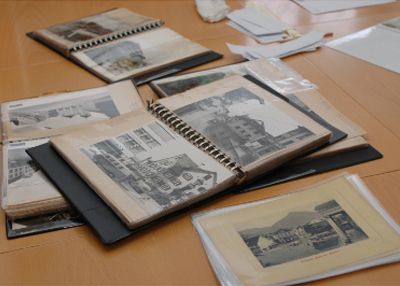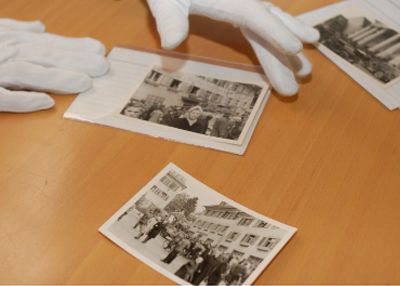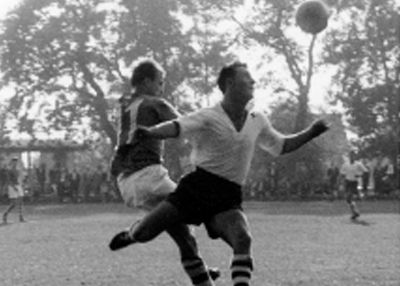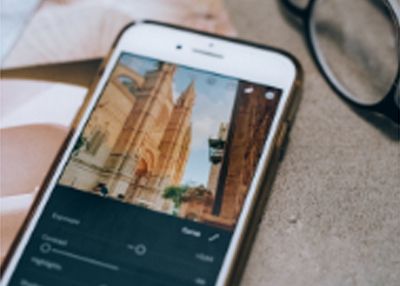Using Photographs with PwD
Photos can trigger really valuable conversations that give the sense of the person, rather than the PwD. Helping the person relating to a time when he/she felt particularly happy or proud by using photos connecting with that period, can help recover a sense of identity and purpose and ultimately to improve the wellbeing of the person. Being able to engage PwD in a meaningful exchange can also make them feel more competent and empowered.
Why is it useful?
- Photos can help tapping into someone's positive emotions of their past and that can bring some positive emotion to them.
- The use of personal and local/regional photographs is the royal road to memory.
- Photos are a good way of facilitating communication helping people to feel more socially integrated and comfortable
- Being able to have a meaningful exchange about their own memories can help the PwD feel more competent and empowered.
- Achieving these goals is often important for the carers as well, allowing them to see the person beyond the disease.
Activities:
1. Where and How to Find Photographs.


What will we gain?
Photos can speak to people on a very personal level. They support the development of meaningful exchanges and help the PwD feel safe and competent. Family members, professionals and carers will have the opportunity to learn new things about the people they care for and their life-history.
ACTIVITY
Download the activity PDF:
Where and how to find photographs .pdf
Step 1: Think about topics you would like to cover
Become acquainted with the persons‘ life story to get an idea which topics are meaningful to the PwD and where to look for photos.
Which topics can you cover?
- home life: family, children, home(s) (e.g. apartment, building a house), housework, garden, pets ...
- leisure time: hobbies and interests, travel, places of identification, sports, membership in an association ...
- education: school, university, classmates, favourite teacher ...
- working life: first jobs, best jobs, wages and working conditions, bosses, colleagues, uniforms ...
- transport: first cars, buses, trams, significant journeys ...
- the local neighbourhood: favourite shops or shopkeepers, markets, significant places in the community such as the town square, the library or the post office, regional customs and festivals ...
Step 2: Where to find photographs
- Start with family photo albums
- Try online searches with simple keywords
- Try asking friends, schoolmates and family
- Ask at your local archive, library or museum
- Look up digital photo collections in your region
Keep in mind:
- Think about what reflects a situation well and is easily understandable.
- You don‘t need the best photo - anything that works well fits!
- You don‘t always need the whole picture - focus on the essentials!
What will we need?
- Photo albums and collections of the person or their friends and family
- Photos retrieved from other sources, such as: local libraries, archives, companies, associations, sport clubs etc.
- Meaningful photos retrieved from the internet
Points for reflection
- To be able to perform this activity, you should first become acquainted with the life story of the PwD
- Look around and learn a little bit about local/regional history, companies, associations etc. to find the right places to ask for photos - they can provide tips on what to use on a local level.
- There’s a multitude of photos you can find on the internet. Keep in mind that you need photos which are meaningful for the PwD. Sometimes symbolic photos will work, but most of the time you’ll need to look for specific photos.
- Local social media groups can be a source or a way to ask for specific photos - but keep in mind that you mostly can’t search for specific photos on social media and that they disappear from the feed after a short while.
- You might need to try with different topics before finding those who are more stimulating for the PwD
- Observe the reaction of the PwD to understand which impact the activity has on him/her
Resources
Europeana (all EU-languages) - Europe’s digital cultural heritage
Austrian National Library - Picture Archives and Graphics Department
ETH Zürich e-pics - platform for images, photographs and illustrations
Other national or regional archives and libraries
Helpful tip: look up libraries and archives in your region with digital collections, e.g. in the Austrian Vorarlberg region: Volare – Vorarlberger Landesrepositorium https://pid.volare.vorarlberg.at/ or your local archive’s website e.g. https://stadtarchiv.dornbirn.at/stadtgeschichte/fotoausstellungen
2. How to Choose from the Multitude of Photos and Topics


What will we gain?
Choosing photos that are really meaningful for the PwD can help pursue the goal to use them to stimulate reminiscence and positive communication with others. On the other hand, people with dementia may become overwhelmed when faced with too many visual stimuli, therefore it is important to be selective and choose a limited number of photos and topics to propose each time. It might also be useful to select pictures showing something specific in relation to the topic that you would like to cover.
ACTIVITY
Download the activity PDF:
How to choose from the multitude of photos and topics.pdf
Step 1: Choose meaningful topics
Think about topics that could be meaningful to the PwD, bearing in mind that the topics that trigger the most memories relate to the main chronological stages of human life - see Activity #1. Consider which topics the person often raises of their own accord.
Step 2: Getting started - select some photos
Start with selecting only a few photos to get a feeling which kinds of photos and topics work well. For example: Try starting with three photos connected by a logical thread.
Step 3: Give it a try
Present one photo at a time to the PwD by placing it within a natural conversation. Observe the PwD‘s reaction carefully: What does he/she say? What is his/her non-verbal language like? Did the photo enrich the conversation? On the basis of these observations, you can refine your choice of topics or photos for the next session. Keep in mind that some photos/topics which don‘t seem to trigger a reaction on one day may be useful in another situation!
Step 4: Collect more photos
Once you feel reasonably confident with the activity, try to expand your search to include more or also more difficult topics.
Useful tips:
- You can keep topics general but not too general
- Think about what reflects a situation well and is easily understandable, like memorable buildings and activities
- Don’t cause stress due to too many details (e.g. the PwD tries to identify the one co-worker, or one specific person in a large wedding party etc.), especially if you have no chance to identify everyone
- Choose pictures that are random enough over too detailed ones
- You don‘t need the best photo - anything that works well fits!
- You don‘t always need the whole picture - focus on the essentials!
What will we need?
- A plan to sort and capture your ideas in terms of topics and choice of pictures.
- You will find different photos from one event or a location - compare them - which one covers the topic best, which one covers what you want to express?
- Notes of the topics you can’t cover with photos - maybe you can find memory documents, objects, videos instead?
Points for reflection
- The right photo might not necessarily be a “good” photo (for ex. perfect from a technical point of view)
- Observe the reaction of the PwD to the pictures chosen: are they meaningful for the person? Do they clearly show the activity / subject etc.?
- Were you able to identify criteria to select pictures that “work” for that specific person?
Resources
- Freitas, Joshua; National Institute for Dementia Education: Cognitive Benefits of Photo Reminiscence Therapy for Dementia Patients Preliminary findings within a narrative framework, 2021.
Cognitive Benefits of Photo Reminiscence Therapy for Dementia Patients.pdf
3. How to Capture Photographs and Prepare them for Upload to the BooM-Box.


What will we gain?
We can identify the pictures we need from a variety of sources and we shall be able to capture and organise them properly (es. Based on tags, topics, sequence…) on the APP to be able to use them with the PwD. Sometimes, the “right” picture can be a detail of a broader image, or the original image might be deteriorated and needs to be improved before use. Learning how to do this helps to increase the use of the app and the positive impact of the activity.
ACTIVITY
Download the activity PDF:
How to capture photographs and prepare them for upload to the BooM-box.pdf
Digital Photos
- If the photos are already digital or digitised, save them to the device you‘re creating the box on.
- You can also use filesharing services or portable drives as long as you can connect them to the device you need it on.
- Download the image to your device or take a screenshot.
Analogue photos, Photo albums etc.
- Just use your devices‘ camera to capture the photos (or a scanning app or device if you like).
- Position the camera where it doesn‘t cause (too much) reflections. Adjust the position or lighting.
- Keep the camera steady and straight - the better the photo and the detail you choose, the less work you will have to do later.
- If you go somewhere especially to take photos for the app (e.g. to the archive or to capture a photo album of the PwD‘s work colleague), try taking photos in various settings with your device beforehand!
Useful tips:
- Choosing only sections of a photo can increase the recognition value of a situation. You can either select and capture only a section of the photo from the outset or crop the image later using the photo editing software on your device.
- Don‘t be too quick to reject photos just because they are not perfect, if they capture the situation well. You can make simple improvements with your photo editing software.
- Consider using theme-based folders and subfolders to organise your photos. You can use them for other content too.
What will we need?
- A scanner or a camera for digitising prints
- Your mobile phone’s or computer’s photo-editing software
Points for reflection
- Is the way you have organised the documents functional? - Can you find what you are looking for?
- How is the quality of the photographs - can you work with them? Can you improve them?
EDUCATOR NOTES
- Identify which organisations / institutions can provide access to the resources looked for
- Acquire information about locally/regionally important events/places/businesses. Archives and museums can help to identify relevant content. Talk about what the participants think are relevant topics for your region and help them identify local content.
- Timelines and chronicles can also provide important information
- When using photos with people with dementia it is important to focus on:
- How to select the pictures in relation to the life-story and interests of the PwD
- How to elicit an exchange around the picture which is meaningful for the PwD
- How to manage emotional reactions to the use of pictures (sadness, frustration, agitation etc.)
GLAM PROFESSIONALS NOTES
- Create a (small) regional photo selection you can provide to people asking for content and care facilities
- Pre-select the right topics relevant to your region (working world, customs, places of identification, events... )
- Create a "sample exhibition" to generate interest and include all segments of the population regarding migration background, gender and social status.
- Be ready to provide technical guidance to users in relation to issues like copyrights, digitisation, download options
- Useful tips for interacting with a PwD who comes to your institution and people who accompany them: When engaging a PwD in a conversation about their past, it is important to ask questions in the proper way to avoid frustrating them. Plain, factual questions can be particularly challenging and stressful for PwD, who may fear they will get the answer wrong or be embarrassed about not being able to remember. Do not exclude the PwD by talking mainly to the person accompanying them.
CARERS NOTES
Which topics can you cover?
It is not unusual for a PwD to have a favourite story which they return to again and again. Quite often the story will relate to a time when the person felt particularly happy or proud. The message behind this repeated story may be that the person is now missing that sense of identity and purpose. Trying to look for pictures related to that topic / period can help engage them in a meaningful conversation and feel better. Some ideas:
- home life: family, children, home(s) (e.g. apartment, building a house), housework, garden, pets ...
- leisure time: hobbies and interests, travel, places of identification, sports, membership in an association ...
- education: school, university, classmates, favourite teacher ...
- working life: first jobs, best jobs, wages and working conditions, bosses, colleagues, uniforms ...
- transport: first cars, buses, trams, significant journeys ...
- the local neighbourhood: favourite shops or shopkeepers, markets, significant places in the community such as the town square, the library or the post office, regional customs and festivals …
You can contact your local archive/museum and explore if they can provide you with a small selection of pictures referring to these topics.
How to communicate with the person with dementia?
When showing the pictures to the PwD, you should try to encourage a conversation but avoid creating frustration because of the memory problems the person experiences.
- Think about how you want to start the discussion on a particular topic beforehand. Avoid getting into too much detail, use more general language. You don’t have to mention specific events, you can talk about a topic in general.
- Do not ask 'Remember when...?' As this kind of question is often a reminder of memories lost.
- It’s better to lead the conversation and allow the person to join in. Instead of posing a question, try leading with ‘At that time, there was…’
- Sharing a memory yourself will give you clues for the sorts of things you will talk about, and may help the person to relax and recall their memories more easily, without fear of mixing things up or forgetting.

 English
English  Polski
Polski  Deutsch
Deutsch  Hrvatski
Hrvatski  Italiano
Italiano  Ελληνικά
Ελληνικά  Svenska
Svenska